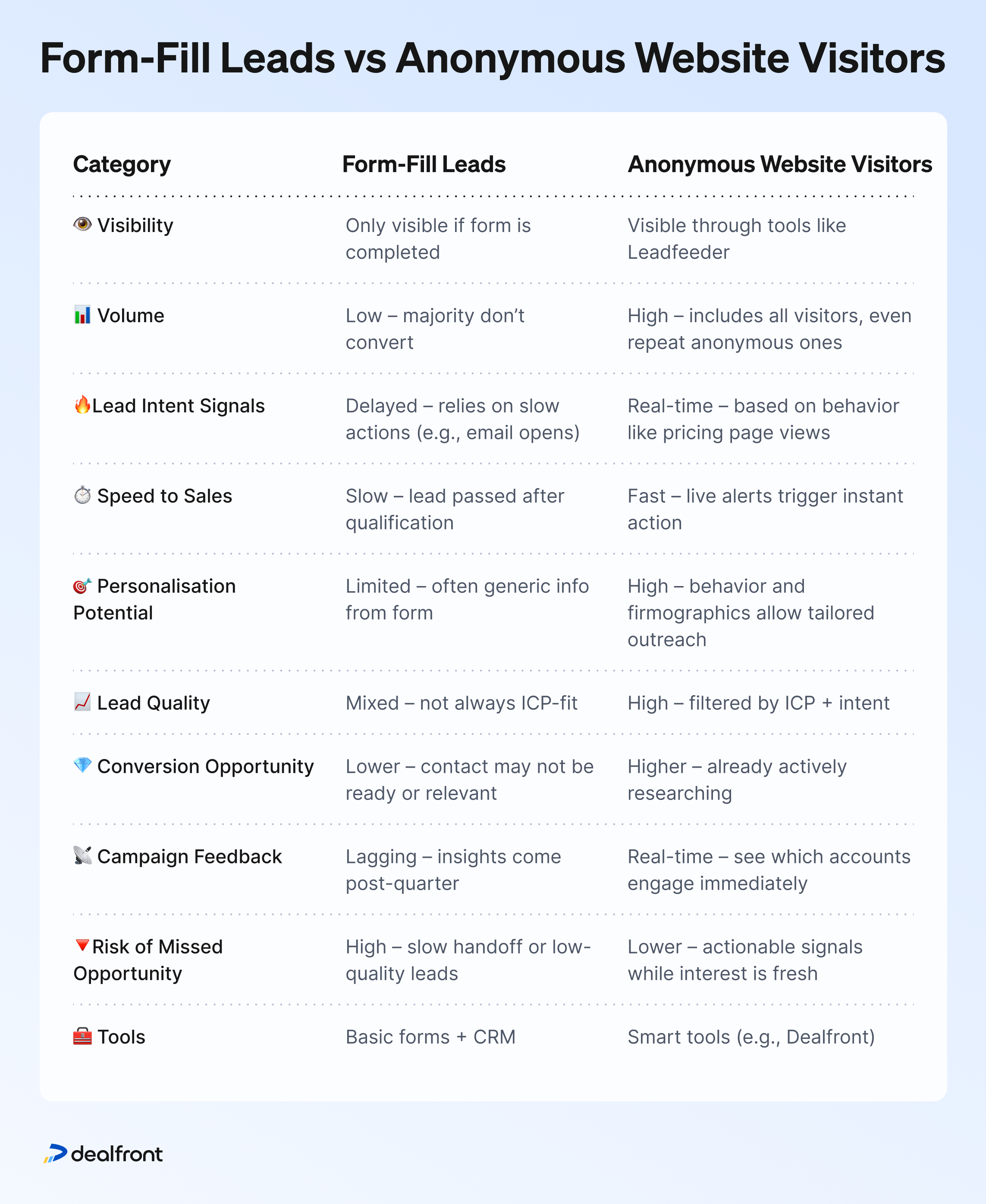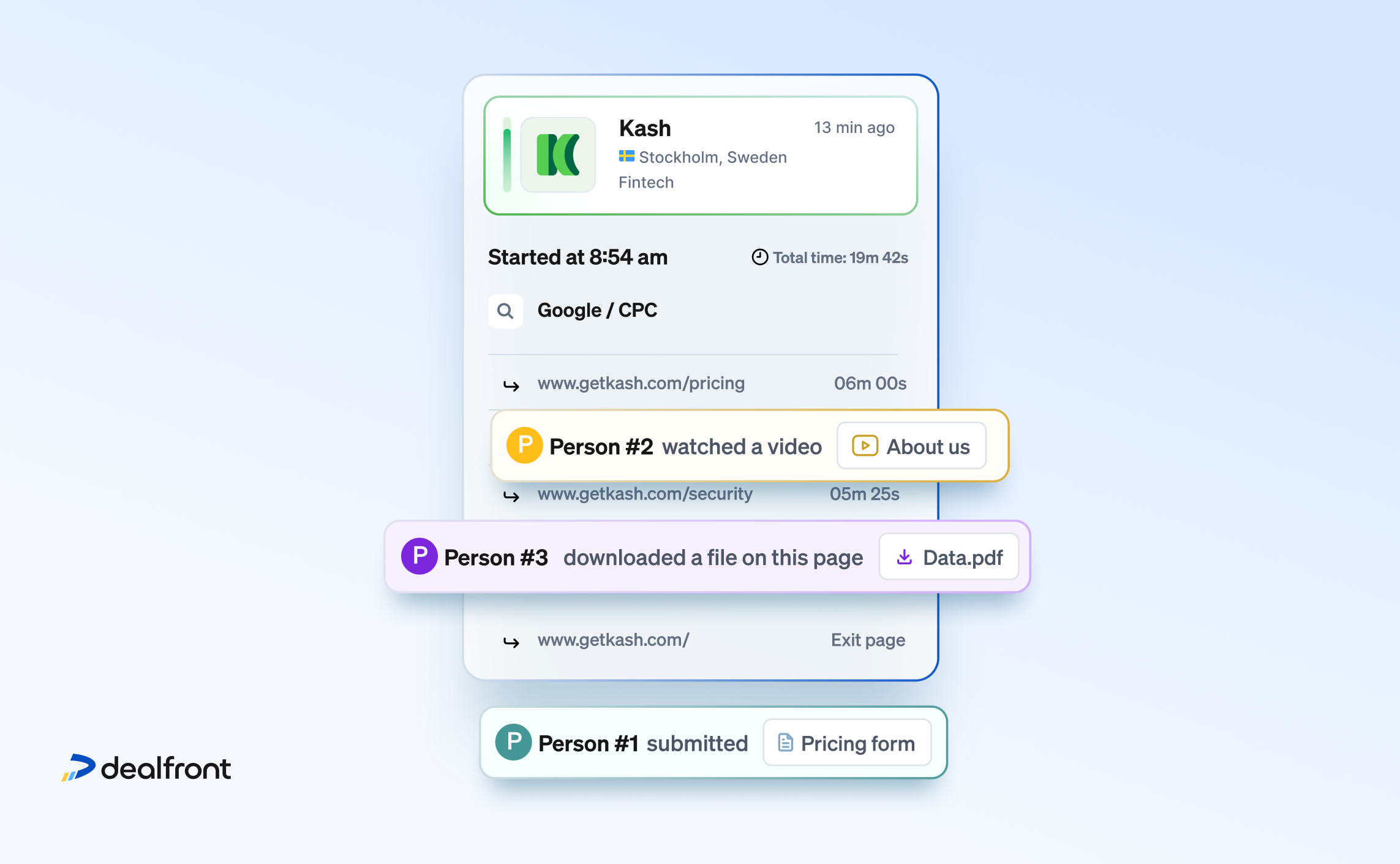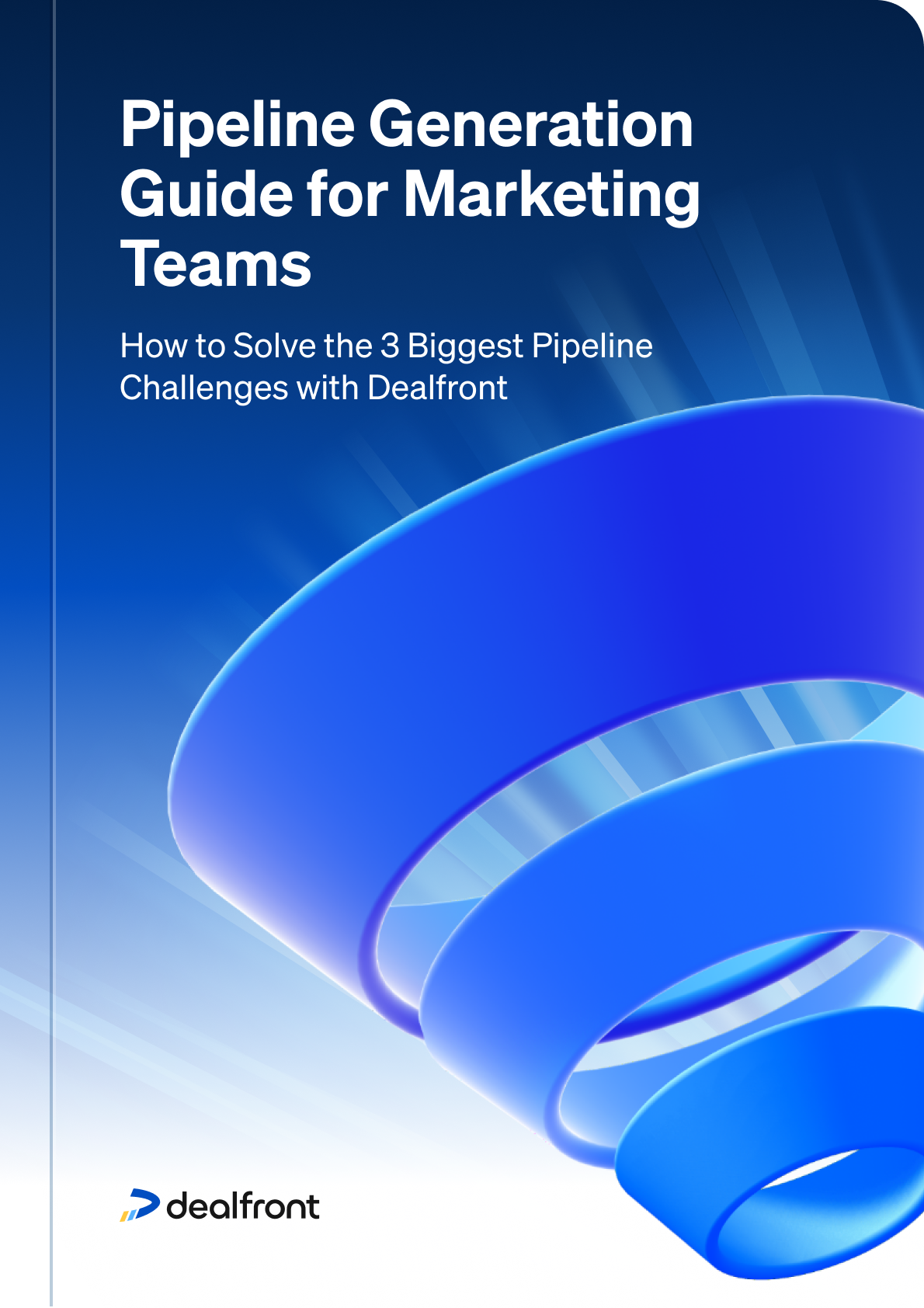60-Second Summary
Sales and marketing alignment remains one of the most critical yet underachieved strategies for driving pipeline and revenue. While lead volume may look strong on paper, without intent, fit, and context, it's meaningless to sales.
Shift from volume to value: Sales wants fewer, more qualified leads that meet firmographic criteria, show intent, and are ready to act—not just content downloaders.
Act in real time: Real-time behavioral signals like website visits and pricing page views should trigger immediate alerts—not delayed MQL scores.
Context equals confidence: Enrich every lead with details about what content they engaged with and where they are in the buyer journey to help sales tailor conversations.
Shared goals, smarter tools: Using intelligent platforms like Dealfront enables marketing to surface actionable insights, reduce guesswork, and deliver the high-intent pipeline sales actually wants.
On paper, the funnel looks healthy, but in practice, the leads feel… lukewarm. Maybe they downloaded a whitepaper, maybe they spent 30 seconds on a pricing page, but are they actually ready to buy? Sales isn’t sure, meanwhile Marketing’s already moving on to the next campaign.
This disconnect isn’t new, and it’s not caused by a lack of effort on either side. It’s a result of something more fundamental: sales and marketing are often working with different definitions of what a good lead looks like, and when it’s time to act on it.
According to LinkedIn, 87% of sales and marketing leaders agree that alignment is critical to growth, yet just 17% describe their collaboration as truly effective. The intention is there, but the execution falls short. So what does sales really want from marketing, and what does it take to deliver it? I’ll give you a hint, it’s not just more leads.
In this article, we’ll explore where the misalignment often starts, what sales actually values in a lead, and how modern marketers can use smarter data, better signals, and tighter timing to deliver the kind of pipeline that sales teams actually want to pick up the phone for.
What Sales really wants from Marketing (it’s not just more leads)
Ask any sales rep what they’d love more of, and the answer probably isn’t “MQLs.” What they want, and need, is confidence: confidence that the person they’re calling is a good fit, is in-market, and has some idea of what the company does.
That kind of lead doesn’t just fall into the funnel by accident. It takes targeted, intentional marketing to get it there.
Here’s what sales teams actually value from their marketing counterparts:
1. Quality over quantity
There was a time when marketing success was measured in sheer volume: more leads, more form fills, more names handed over to sales. But high-volume, low-fit leads quickly become a huge drain on time, and sales teams were feeling the brunt of it. Sales really don’t want a long list of cold contacts; they want a shortlist of the right ones.
That means:
The company is a firmographic match (industry, size, location)
The person has decision-making power or influence
There are signs of buying intent or active interest
The timing makes sense (they’re not just looking for “someday,” but soon)
When marketing focuses on quality over quantity, it does more than keep sales reps happy. It shortens sales cycles, improves conversion rates, and helps both teams spend their time where it matters most.
The good news is, you don’t need a crystal ball to do this. With access to intent data, website behavior, and real-time firmographics, marketers can filter out the noise and zero in on the leads most likely to convert, before competitors even know they’re in-market.
2. Timely signals
Speed and timing matters. In fact, timing can be the difference between a warm conversation and a cold rejection. That’s why one of the most valuable things marketing can offer is real-time insight into buying behaviour.
Consider this: a company visits your website, checks out your pricing page, and downloads a product comparison guide, all in the same day. If that intel reaches sales two weeks later via a monthly report or MQL score? The moment’s already gone.
Sales needs to know who’s showing intent right now, not after they’ve already gone with a competitor.
That means surfacing things like:
Which companies are currently active on your site
Which pages they’re viewing (and how long they’re staying)
What content they’re consuming and what it suggests about their stage in the buyer journey
This kind of real-time behavioural insight empowers sales to follow up with relevance, urgency, and context, which leads to better conversations, more opportunities, and a higher close rate.
One of the main challenges though is that a lot of marketing teams don’t have the tools in place to identify these signals fast enough, if at all. But when you can deliver this information while the interest is still fresh, you’re not just handing off a lead, you’re passing on momentum. Tools like Dealfront help marketing teams monitor website activity in real time, identify anonymous visitors, and alert sales when key accounts engage, all without relying on a form fill. That means less waiting, less guesswork, and more action when it counts.
It's all about quality over quantity. We need leads that are truly relevant, so that we're not wasting time and can focus on the right deals.
3. Context is key
Handing over a lead without context is a bit like throwing a dart at the board with the lights off… it’s very unlikely it'll land where you want it to! Sales doesn’t just need to know who to talk to, they need to know why now’s the right time, and what matters most to that prospect.
Context builds confidence and it helps sales tailor their outreach, connect faster, and avoid the dreaded “Why are you calling me?” response. Here’s what that context looks like in practice:
What pages the lead visited: homepage, product details, pricing, careers? Each tells a different story.
How long they stayed: a 5-minute visit suggests interest; a 5-second bounce suggests a wrong turn.
What content they downloaded, watched, or shared: webinars? Case studies? A buying guide? These all hint at intent and stage.
Which campaigns they came from: did they click a LinkedIn ad? Organic search? Referral from a review site?
When marketing packages this information up for sales, ideally in a format that’s easy for them to act on, it makes every outreach smarter, more relevant, and more likely to convert. This is where tools like Dealfront can quietly work behind the scenes to bring it all together. By connecting campaign data, website behaviour, and firmographic insights into a single view, marketers can tee up sales with everything they need to hit the ground running.
4. Data that sales can trust and use
Even the most beautifully crafted lead handoff will fall flat if sales doesn’t trust the data behind it. If your sales team has ever said, “Marketing’s leads never convert,” or “These accounts aren’t even in our ICP,” you’re not alone. According to a Forrester study cited on LinkedIn 9 in 10 sales and marketing professionals still cite misalignment on lead quality as a major pain point.
Nothing stalls sales momentum like second-guessing the source. If lead data is inaccurate (think: wrong company size, old job title, bounced email) trust erodes fast. And once sales stops trusting the leads, it doesn’t matter how many you send, they’ll be ignored, deprioritized, or quietly pushed to the bottom of the queue.
It all boils down to how much trust can be placed in the data and leads you’re handing over. Sales needs to know that the accounts they’re being asked to pursue are:
In the right industry and region
The right company size or revenue band
Showing recent, relevant buying behaviour
Connected to real, reachable decision-makers
Essentially, leads need to be qualified as both matching the ICP and as showing genuine potential, not just anyone who downloaded a whitepaper.
This is where marketing’s data sources and enrichment tools really prove their worth. To make sure you’re investing and using the best tools, consider: are you relying on outdated third-party lists? Or are you feeding sales with up-to-date firmographic and technographic insights tied to actual on-site activity?
The best pipeline generation platforms help bridge this gap by combining verified company data, real-time website activity, and intent signals into one clear picture. That means sales isn’t chasing ghosts, they’re engaging with qualified prospects who are active, relevant, and already in-market.
When sales trusts the leads, they’re more likely to follow up fast, and that’s when the magic happens.
5. Warmer conversations mean better conversations
For sales, few things are more frustrating than cold outreach that goes… well, cold. No context, no awareness, no idea why they’re reaching out to this person in the first place.
But imagine instead opening a conversation with something like: “I noticed your team was checking out our pricing page after reading about [relevant product feature] and thought it might be worth a quick intro.”
This is the kind of warm, relevant context that gives sales a head start. Leads are far more likely to respond when they’re already aware of your brand, have shown interest in your content, or are actively researching a solution. But it’s not just good for sales, it’s good for marketing too because every meaningful sales interaction that starts with marketing-sourced insight strengthens the trust between teams.
By giving sales a window into real buyer behaviour with information about what pages they’ve visited, what content they’ve engaged with, or how long they stayed, marketers empower them to start conversations with confidence, relevance and timing.
Tools like Dealfront surface these signals automatically, turning anonymous intent into the warm leads that sales actually wants to speak to. So, instead of chasing cold leads, reps are stepping into informed, high-conversion conversations.

Why B2B marketing misses the mark
If we’re being honest, marketing has never had more tools, more data, or more pressure to perform. But somehow pipeline gaps still persist. Sales is frustrated while marketing’s under scrutiny… So what’s going wrong?
Here’s four key areas where well-meaning strategies often fall short, and why smarter, more connected tools are helping close the gap:
1. Too much faith in form fills
We’ve all built lead gen campaigns around gated content. But the reality is that the vast majority of website visitors will never fill out a form. Today’s buyers want to stay anonymous as they research. They might visit your site three, four, even ten times before ever identifying themselves, if they do at all. That means if your strategy depends solely on forms, you’re missing a huge chunk of buying intent.
2. Slow, static lead scoring
Traditional lead scoring often works in slow motion, tracking things like email opens or webinar signups, while completely missing the real-time behaviour that shows someone is ready to buy now.
By the time marketing hands the lead to sales, that window of opportunity may have already closed, or worse, a competitor could have swooped in faster. Many of today’s modern solution platforms solve this by detecting active buying signals in real time, surfacing accounts that match your ICP and are showing intent right now.
3. One-size-fits-all campaigns
Blanket email blasts, broad ad targeting, and generic content are the enemy of revenue teams today. Buyers are increasingly expecting personalisation, so mass campaigns without segmentation or fit do more harm than good. Ultimately these campaigns are burning budget, fatiguing your audience, and fail to resonate with pretty much anyone.
Successful marketers, however, focus on quality over quantity, narrowing in on high-fit, high-intent accounts and crafting messaging that speaks to their specific pain points and journey stage.
4. No visibility until it’s too late
Evaluating campaign success at the end of the quarter, is too late and means you’ve spent the last three months flying blind. Marketers need to know in real time which messages, assets and tactics are resonating, and more importantly, which ones are attracting the right kind of traffic. Otherwise, you’re optimising for vanity metrics instead of pipeline.
The right tools will give marketers instant feedback on which companies are visiting, how they behave on-site, and whether they align with your ICP. So knowing how your campaign is performing in real-time means you can double down on what’s working while it’s still working, and without losing opportunity or momentum.
5. Acting late = losing pipeline
The cost of acting late, or acting on the wrong signals, is huge. We’re not just talking about wasted budget, it’s actually far worse; you could be losing pipeline directly to your faster, more informed competitors.
B2B buyers are moving faster, researching more independently, and engaging with brands long before they ever reach out. If your marketing doesn’t surface that intent early, and connect it to sales fast, someone else will.

How to actually deliver what sales wants
There is good news when it comes to the dichotomy of making sales happy and still running effective marketing: the two aren’t mutually exclusive. Sales frustrations aren’t inevitable and with the right approach, and the right tools, marketing can become sales’ most valuable partner, not just a lead factory.
Here’s how to make that shift:
Step 1: Spot buying signals before the form fill
Up to 70% of the B2B buyer journey happens anonymously, long before a prospect ever fills out a form or books a call. That doesn’t mean they’re not interested. In fact, if someone’s on your pricing page, browsing your product features, or revisiting your blog twice in one week, they’re sending smoke signals. You just need to be able to spot them.
With website intelligence tools you can uncover which companies are visiting your site, what they’re looking at, and how engaged they really are, all before they raise their hand. That means marketing can surface warm accounts early, and sales can reach out with better timing and context.
Step 2. Prioritize high-fit accounts with real buying intent
Not every website visitor is a potential lead. Just because someone clicked a blog post doesn’t mean they’re worth a sales call. The real value comes from understanding who they are and what they’re doing.
Marketing’s job is to combine firmographic data (like company size, industry, revenue, tech stack) with behavioural intent (recent activity, repeat visits, specific page views) to identify which accounts are actually worth pursuing.
This should leave sales with tighter, smarter target lists that mean they can spend more time on the right conversations, not just chasing cold contacts or low-fit prospects. It also builds trust between teams, because sales knows the leads they’re getting have real potential to convert.
Step 3: Give sales the full story
It’s not enough to send sales a name, job title and email address and think that’s a good job done. What it is, is a cold intro at best. And what sales really needs is context: What content did they read? What pages did they view? Are they new to the brand or returning? What challenge are they likely trying to solve?
This kind of narrative, sometimes called a “lead story”, helps reps open warmer conversations, tailor their pitch, and build rapport faster. And it’s exactly what platforms like Dealfront can deliver: rich behavioural insights paired with company-level data that bring a lead to life.

Step 4: Act fast with shared metrics and real-time alerts
Speed matters. If a hot prospect hits your site and shows buying intent, waiting three days for a CRM update is a missed opportunity.
Marketing and sales should agree on shared signals (e.g. pricing page views, resource downloads, high time-on-site) and set up real-time alerts when key accounts engage. That might mean an automated Slack message, a quick email, or a dashboard both teams can check daily.
The faster sales can act, the higher the chance of converting curiosity into a meaningful conversation
Remember
The disconnect between sales and marketing isn’t about effort, it’s about alignment. Sales doesn’t need more leads, it needs better ones: leads that are relevant, timely, and backed by trustworthy, actionable data. And marketing teams, for all their creativity and effort, often find themselves judged not by output, but by outcomes, particularly whether those outcomes move the revenue needle.
Closing this gap means changing how we think about lead generation. It’s not about volume anymore, it’s about velocity, intent, fit, and timing. When marketers focus on surfacing real-time buyer intent, delivering context-rich lead handoffs, and working from a shared definition of a high-quality lead, the results are powerful with faster follow-ups, warmer conversations, and stronger conversions.
Most successful B2B marketing teams today aren’t just creating content or running campaigns, they’re enabling revenue. They’re using platforms like Dealfront to transform anonymous website visitors into qualified pipeline opportunities, giving sales the insights they need to act with confidence and urgency.
If you're in B2B sales or marketing and you're struggling with lead quality, sales follow-through, or pipeline performance, remember, the answer isn’t more leads, it’s smarter ones. Similarly, it’s not more tools you need, but better-connected ones, and it's not about finger-pointing, but instead it’s about creating systems and strategies that bring sales and marketing closer together, around shared goals, shared definitions, and shared wins. When sales and marketing finally align, not just in theory, but in practice, that’s when growth really happens.
B2B Sales & Marketing FAQs
Why is there often a disconnect between B2B sales and marketing teams?
Why is there often a disconnect between B2B sales and marketing teams?
The disconnect usually stems from misaligned goals, definitions of qualified leads, and a lack of shared data. Marketing focuses on lead generation, while sales prioritizes conversion and revenue. Without clear communication and aligned metrics, both teams struggle to support each other effectively.
What does “lead quality” mean in B2B sales and marketing?
What does “lead quality” mean in B2B sales and marketing?
Lead quality refers to how likely a lead is to convert into a paying customer. High-quality leads are typically well-matched to your ideal customer profile (ICP), show buying intent, and are at the right stage of the buyer journey. Better lead quality means higher close rates and more efficient sales processes.
How can marketing deliver better leads to sales?
How can marketing deliver better leads to sales?
Marketing can improve lead quality by using intent data, tracking website behavior, and enriching leads with firmographic information. Tools like Dealfront help marketers identify in-market buyers and provide sales with deeper context, enabling more relevant outreach and faster follow-up.
What is buyer intent data and why is it important?
What is buyer intent data and why is it important?
Buyer intent data shows which prospects are actively researching solutions like yours. It helps marketing prioritize warm leads and allows sales to reach out at the right time with the right message. Intent data shortens sales cycles and improves conversion rates.
How can B2B companies align sales and marketing teams more effectively?
How can B2B companies align sales and marketing teams more effectively?
Sales and marketing alignment starts with shared definitions of qualified leads, joint KPIs, and integrated tools. Regular feedback loops, mutual accountability, and platforms that unify data (like Dealfront) are key to breaking down silos and driving revenue together.
What’s the difference between lead volume and lead quality?
What’s the difference between lead volume and lead quality?
Lead volume is about quantity, basically, how many leads are generated. Lead quality is about effectiveness, how many of those leads are actually ready to buy. High volume with low quality wastes sales resources. A smaller number of high-quality leads often delivers better ROI.
How can I improve B2B lead generation without overwhelming my sales team?
How can I improve B2B lead generation without overwhelming my sales team?
Focus on smart lead generation over mass lead capture. Use tools that prioritize buyer intent, enrich lead profiles with relevant context, and score leads based on fit and timing. This ensures sales receives fewer, but higher-value leads they can act on quickly.

